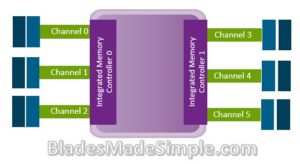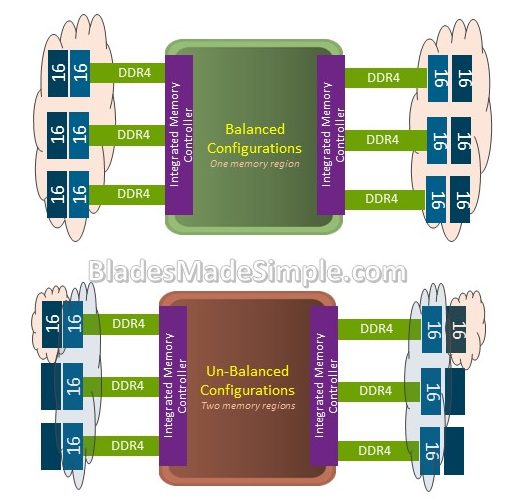The new architecture of the Intel Xeon SP (aka Skylake) CPU includes more memory channels, which is creating some uncertainty on best practices. In today’s post, I’ll show you the best configurations to consider to help drive high memory performance.
 Each Intel Xeon SP CPU has 6 memory channels, each with up to 2 DIMMs per channel (DPC) supporting a maximum of 12 DIMMs per CPU, or 24 DIMMs per server. While the maximum memory speeds available range from 2133, 2400 or 2666 (depending upon the CPU selected), the scope of this post is to review the memory population recommendations.
Each Intel Xeon SP CPU has 6 memory channels, each with up to 2 DIMMs per channel (DPC) supporting a maximum of 12 DIMMs per CPU, or 24 DIMMs per server. While the maximum memory speeds available range from 2133, 2400 or 2666 (depending upon the CPU selected), the scope of this post is to review the memory population recommendations.
There are some general guidelines on how to optimize your memory performance:
- Use a balanced configuration. In a balanced configuration, the memory is interleaved equally across all DIMMs; they uniformly have high bandwidth and they have a centralized memory region. The best ways to be balanced are to use identical DIMMs in all location (size, speed, etc) and make sure all memory channels are populated equally. To assist you in reviewing what configurations are best for being balanced, download Intel_Xeon_SP_Memory_Recommendations_v4 (PDF). Note this shows a 2 CPU environment. For single CPU, simply use half of the recommended designs.
- Use identical DIMM types in your server. This means use the same ranks, size, and speed.
- Use 1 DPC per integrated memory controller or duplicate the memory channel use across both memory controllers.
In case you are wondering what the big deal is, in an “un-balanced configuration“, the memory is broken up into multiple memory regions creating an environment leading to unpredictable performance. Below is an image to help demonstrate balanced vs un-balanced memory configurations.
In conclusion, make sure you take the time to understand what your options are. The PDF linked above (Intel Xeon SP Memory Performance Recommendations) should aid you in finding the right balance of memory is for your blade server. If I’ve left off any important information, if you’d like the Excel spreadsheet of the chart in the PDF, or if you think something’s not right, leave a comment below or email me at kevin AT bladesmadesimple.com Thanks for reading.
 Kevin Houston is the founder and Editor-in-Chief of BladesMadeSimple.com. He has 20 years of experience in the x86 server marketplace. Since 1997 Kevin has worked at several resellers in the Atlanta area, and has a vast array of competitive x86 server knowledge and certifications as well as an in-depth understanding of VMware and Citrix virtualization. Kevin has worked at Dell EMC as a Server Sales Engineer covering the Global Enterprise market since August 2011 and currently works as a Chief Technical Architect supporting the Central Region.
Kevin Houston is the founder and Editor-in-Chief of BladesMadeSimple.com. He has 20 years of experience in the x86 server marketplace. Since 1997 Kevin has worked at several resellers in the Atlanta area, and has a vast array of competitive x86 server knowledge and certifications as well as an in-depth understanding of VMware and Citrix virtualization. Kevin has worked at Dell EMC as a Server Sales Engineer covering the Global Enterprise market since August 2011 and currently works as a Chief Technical Architect supporting the Central Region.
Disclaimer: The views presented in this blog are personal views and may or may not reflect any of the contributors’ employer’s positions. Furthermore, the content is not reviewed, approved or published by any employer. No compensation has been provided for any part of this blog.
Pingback: Why You Should Consider Changing Your Memory Architecture » Blades Made Simple
Pingback: 2019 – Year in Review » Blades Made Simple
Pingback: Recommended Memory Configurations for Skylake CPUs – Real World UCS